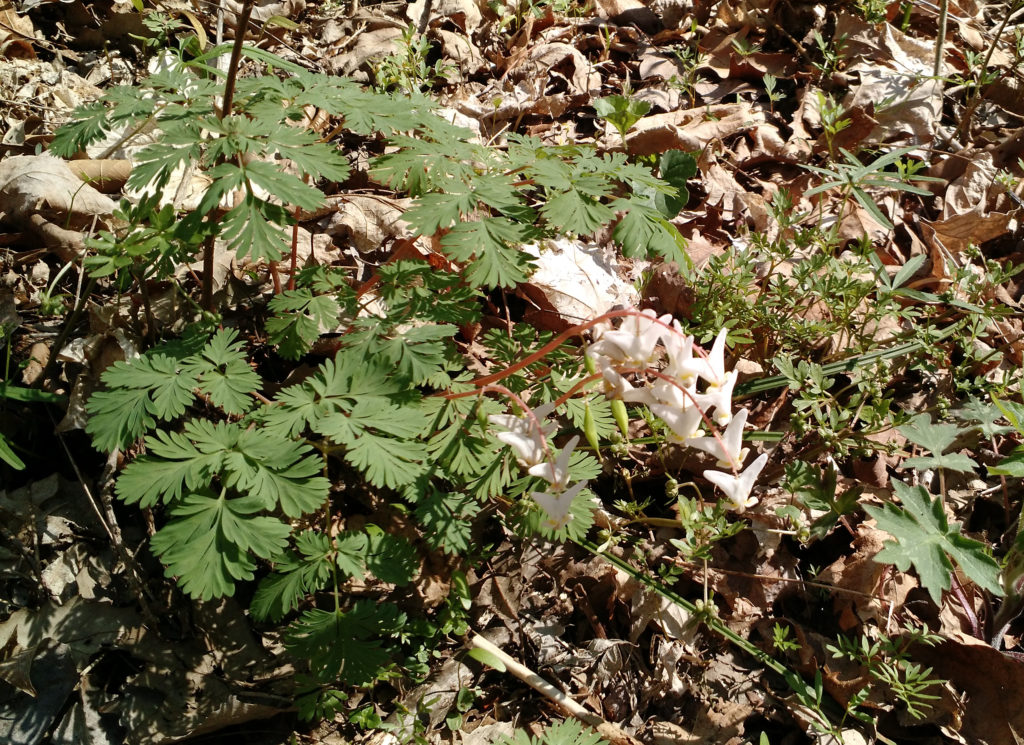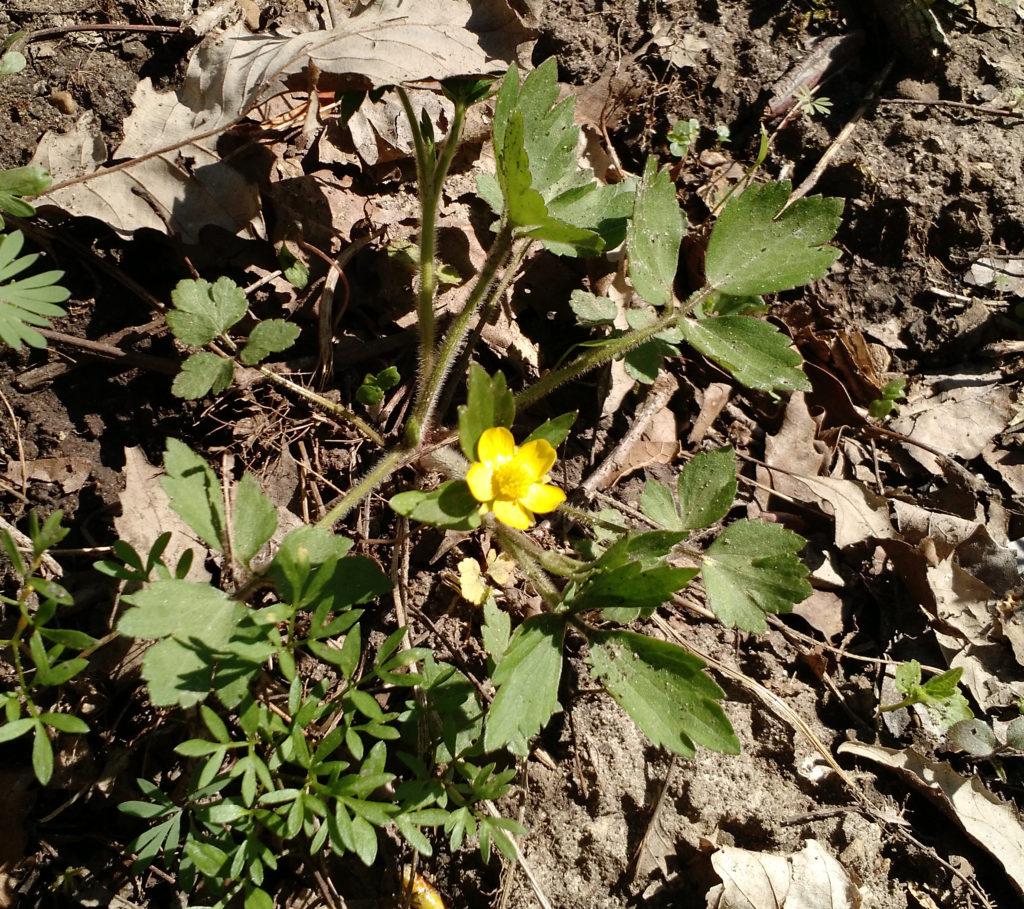Don’t cross that bridge, until you can do it with your (goat) girl on one hand and your stick in the other.
Tag: hiking
Ankle dorsiflexion turns out to be useful
For going on two years now, I’ve been working on recovering the ability to squat. I’m not talking about the exercise called the squat, although I do that too. I’m talking about the ordinary human resting posture of lowering your butt down near your heels and relaxing there.
The reason I’ve been working on it for two years is that I haven’t been flexible enough to get into a proper squat. My flexibility has been improving pretty slowly, but it has been improving—I can now get down into a pretty good squat if I have a bit of heel support.
The change that’s been driving the improvement, but (as needing heel support shows) the area where I still need to improve, is ankle dorsiflexion. (Dorsiflexion is pulling your toes up toward your knees. It’s the opposite of plantarflexion, which is pointing your toes away from your knees.) To improve my ankle dorsiflexion I’ve been doing a variety of calf stretches with both straight and bent knees.
I don’t really have a before picture, but my ankle flexion used to be just about zero. That is, my ankle would bend 90° (as in standing up straight) no problem, but bending it up further simply didn’t happen. I used to think that was normal, and didn’t really try to stretch my calf to go beyond that range.
Now that I’ve been doing my stretches for a while, I can manage a bit of dorsiflexion:
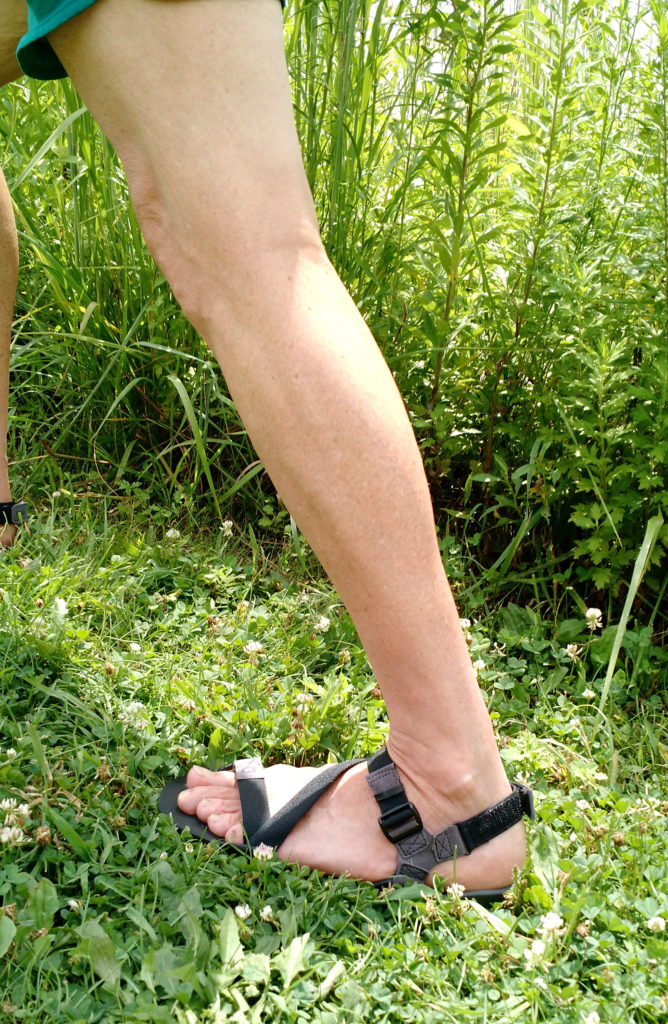
The thing that prompted me to write this post, though, is not that I’m a few degrees closer to being able to squat, but that this added range of motion turns out to be useful for other stuff. In particular, as demonstrated in this picture, walking uphill.
There’s not a lot of call for walking uphill in east-central Illinois, but you can find places where it’s possible to go up a hill. Jackie and I visited one a couple of weeks ago, and I found myself putting my new range of motion to good use.
See, if you can dorsiflex your ankle, then the heel of your back foot can stay on the ground as you stride uphill. This lets you use your glutes to drive yourself forward and upward.
If you can’t dorsiflex your ankle, then your back heel comes off the ground as soon as your front foot goes forward. Now you’re stuck pushing yourself up with your relatively wimpy quads and calf muscles.
I’m not surprised, I just hadn’t though of it. This natural movement stuff turns out to have all kinds of side benefits.
Tree identification workshop (and fitness)
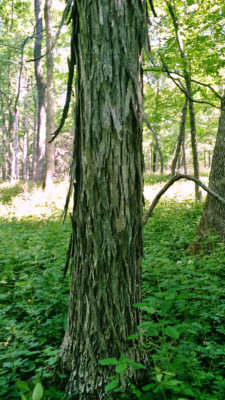
Jackie and I attended a tree identification workshop at Allerton Park yesterday.
Both my parents are naturalists, and my brother took some botany classes as part getting his PhD in science education, so they all know all the trees we’re likely to see in any of the places where we’ve ever lived. They routinely identify the trees for me when we’re walking. If I’d had any sense, I’d have learned all that stuff myself long ago.
Sadly, I have a lazy brain—the sort that figures that if other people will identify the trees for me, there’s no need for me to learn how to do it myself. So, I had to subject myself to this workshop to try and catch up.
It was a very well done workshop. We spent about half an hour going over basic terminology of tree characteristics—alternate versus opposite, simple versus compound, pinnate versus palmate, petioles versus petiolules—then we spent about three hours hiking through Allerton Park on the south side of the Sangamon River, before breaking for lunch. After lunch we spent another three hours hiking on the north side of the river, looking at the trees found over there.
We learned to identify maybe 30 species, with enough repetition of the more common species that we might actually be able to remember them.
It was good.
With all the time and effort I’ve been putting into fitness of late, I’ve been feeling just a little smug—I’m in so much better shape than I was nine or ten years ago. But this outing showed me that any such smugness is unjustified—everybody in our group of 20 or so, including some people older than Jackie and me, held up just fine to the rigors of five or six hours on our feet in the woods, some of it hiking off-trail. Jackie and I held up just fine too, but I was pretty tired at the end. (And managed to jam my ankle at some point, which wasn’t a problem during the event, but got sore in the night.)
It was a good reminder that endurance is a very complicated thing. Being in shape to walk briskly for 10 or 15 miles is not the same as being in shape to alternate walking and standing for the same number of hours. Adding effort in a mental dimension—trying to learn the trees, keeping an eye out for things like poison ivy, nettle, and tripping hazards—also makes things more taxing, something that’s easy to forget.
Now we need to get back to Allerton reasonably soon—before we forget everything—and see how many of those trees we can still identify.
Deliberately hilly walk
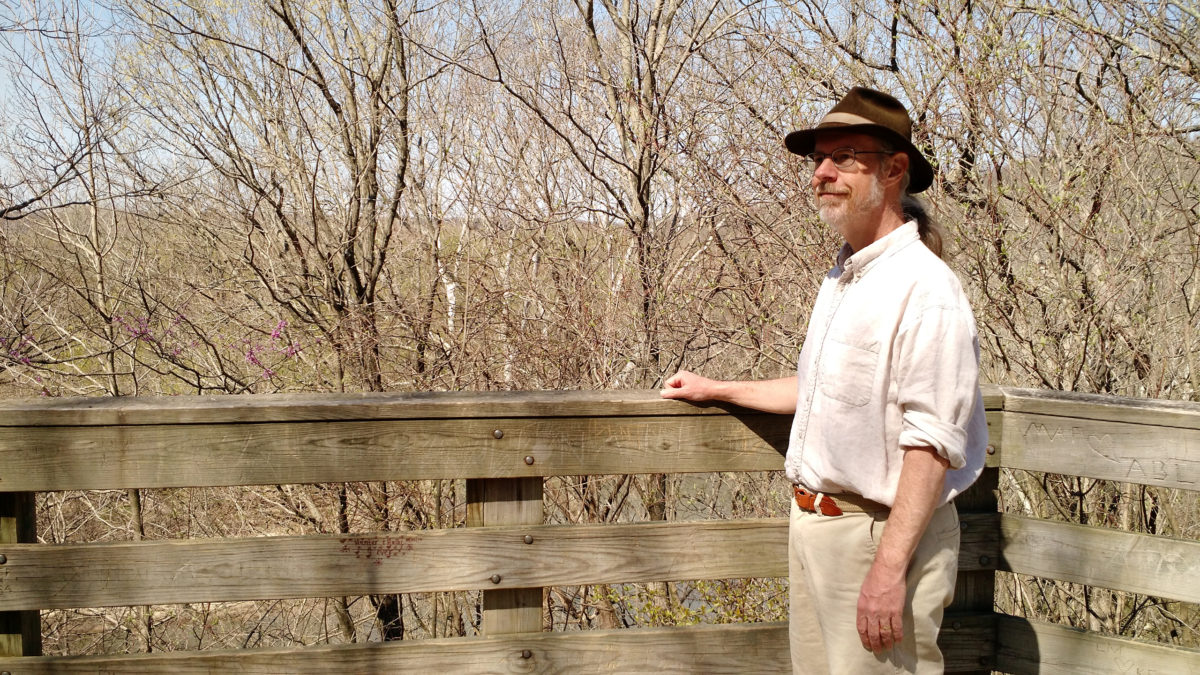
I think Champaign-Urbana is great. The university gives it cultural and scientific amenities far beyond its size. It’s a cheap place to live, which not only enables my lifestyle, it enables the lifestyle of any number of clever creative people who choose to live where they can make enough from their art to support themselves.
Just about the only thing that CU really lacks is relief—that is, a variation in height from one place to another.
What I mean to say is: it’s really, really flat. Take for example, this image:
That’s the hilly direction. I’m looking toward Yankee Ridge, which is about three miles away from where I’m standing. It may not look like much, but that hill in the distance is a big deal when you’re on a bicycle. At least, it is if you’re used to riding in Central Illinois.
Given the terrain, we don’t get enough hiking on hills, unless we make an effort to go to the hills. So, that’s what we did yesterday. We drove to Fox Ridge, a nearby state park which has some hills.
I remember hiking in Fox Ridge last summer, shortly before our big Kal-Haven trail hike, and finding that we were in pretty good shape for dealing with the hills, despite our very limited practice. That was less true this spring. I was a bit tired from my unexpectedly fast run the previous day, and we were both a bit out of shape from a lack of hills over the winter.
Still, we did okay. We saw some spring wildflowers, like these dutchman’s breeches:
And this solomon’s seal:
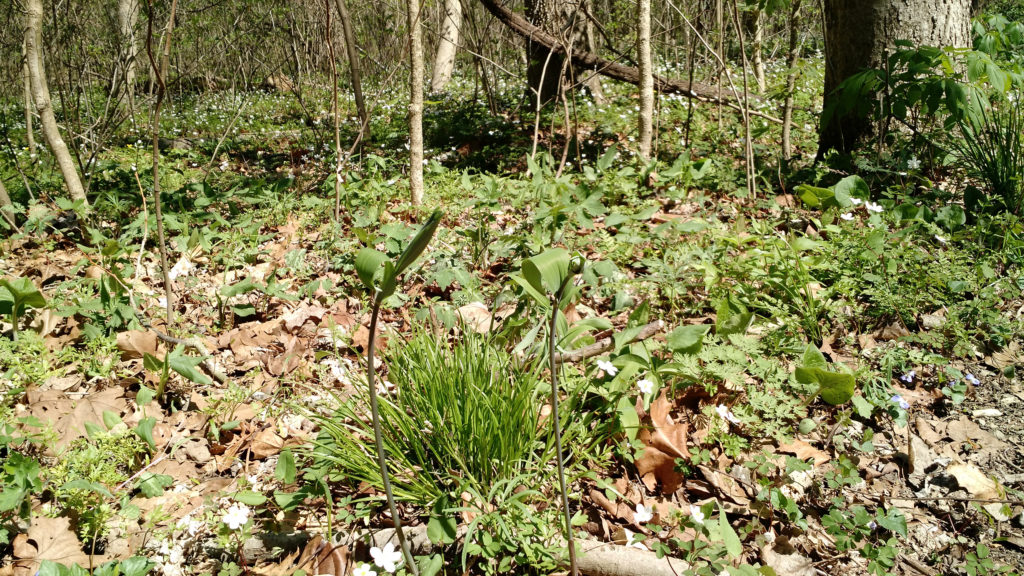 Total hiking was probably only a little over 3 miles, but the hills made it a very different sort of hike than our much longer hikes closer to home. Plus, we got to spend time in the woods.
Total hiking was probably only a little over 3 miles, but the hills made it a very different sort of hike than our much longer hikes closer to home. Plus, we got to spend time in the woods.
So, that’s another bonus of Champaign-Urbana: We’ve got Fox Ridge State Park just 50 miles away.
Dayhiking the Kal-Haven Trail
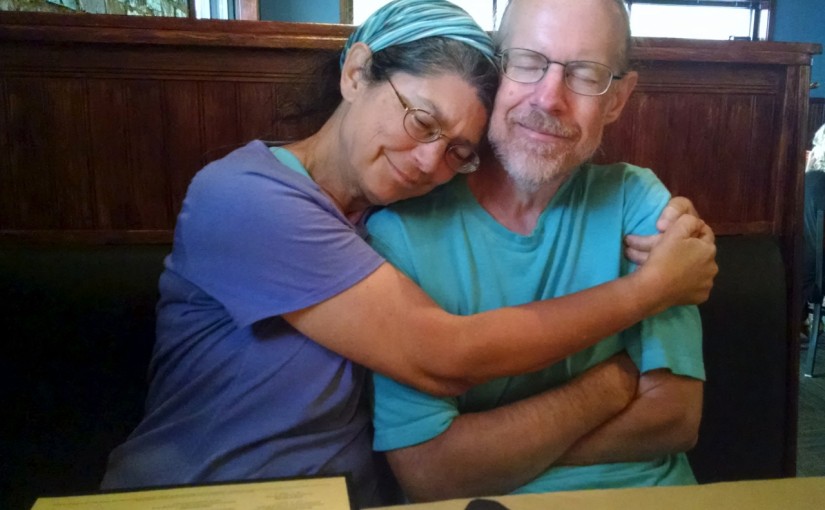
Two years we trained for this particular very long walk, without getting it together to make the trip to Kalamazoo during the few summer weeks when the days are long enough to through-hike the Kal-Haven Trail in a day. This year we made it happen.
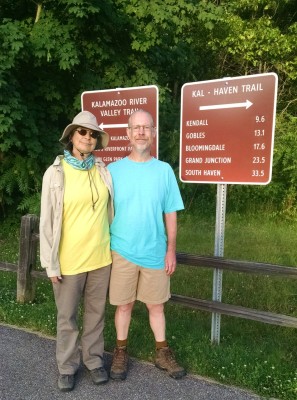 We meant to be at the trailhead by dawn which was 6:05 AM, but breakfast and final checking of gear took a little longer than we’d hoped. It was almost one hour later when we posed for pictures in front of the sign. We were walking just a few minutes later. Jackie started Endomondo at 7:06.
We meant to be at the trailhead by dawn which was 6:05 AM, but breakfast and final checking of gear took a little longer than we’d hoped. It was almost one hour later when we posed for pictures in front of the sign. We were walking just a few minutes later. Jackie started Endomondo at 7:06.
My brother, Steven Brewer, had offered to drive support, and did a great job. He drove us to the trailhead, met us at four or five points along the way to provide fresh, cold bottles of water, laid out a sumptuous, bounteous feast for lunch, and took pictures along the way. (He has written his own account of the walk.)
We made excellent time through the morning, clocking out a whole series of sub-18-minute miles, and reached Gobles a few minutes before noon.
The crushed limestone surface was great—smooth, level, hard enough for efficient walking, gentler than concrete. (There was one stretch in Bloomingdale that had been resurfaced with asphalt, which was much harder on the feet.)
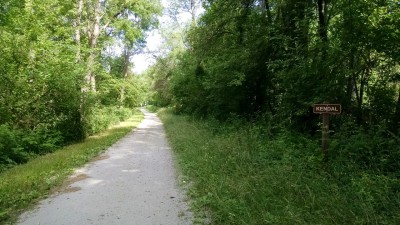 There was one downside to the surface, though. Almost as it it were designed that way, my tread caught the limestone and pitched it forwards into my boots. I had to stop every few miles and shake a teaspoon of limestone grit out of my boots.
There was one downside to the surface, though. Almost as it it were designed that way, my tread caught the limestone and pitched it forwards into my boots. I had to stop every few miles and shake a teaspoon of limestone grit out of my boots.
Still great for walking on, and kinda pretty.
I had made sandwiches, and Steven had gotten all sorts of stuff to go with them—german potato salad, red bananas, hummus, flat bread, raspberries, raw veggies, and brownies for desert.
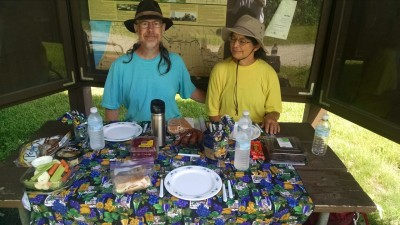 Behold our awesome lunch, served trailside, complete with cloth napkins.
Behold our awesome lunch, served trailside, complete with cloth napkins.
It took some minutes to loosen up after we got started going again, but we were almost matching our pace, carrying on with sub-20-minute miles right along until we hit mile 25.
I was still feeling pretty good then. We had slowed down a bit, but as we passed mile 27, I tweeted, “Has blown through marathon distance and is pressing for 33.5 miles. South Haven here we come!”
Pretty much just about then, though, I started dragging a bit. We had walked farther than we’ve ever walked before, and the last few miles were tough.
We pressed on, walking at perhaps a 22-minute pace. Jackie held up better than I did, as you can perhaps tell from this picture, taken very close to the end of the trail. Steven had suggested that we smile, and both Jackie and I did our best:
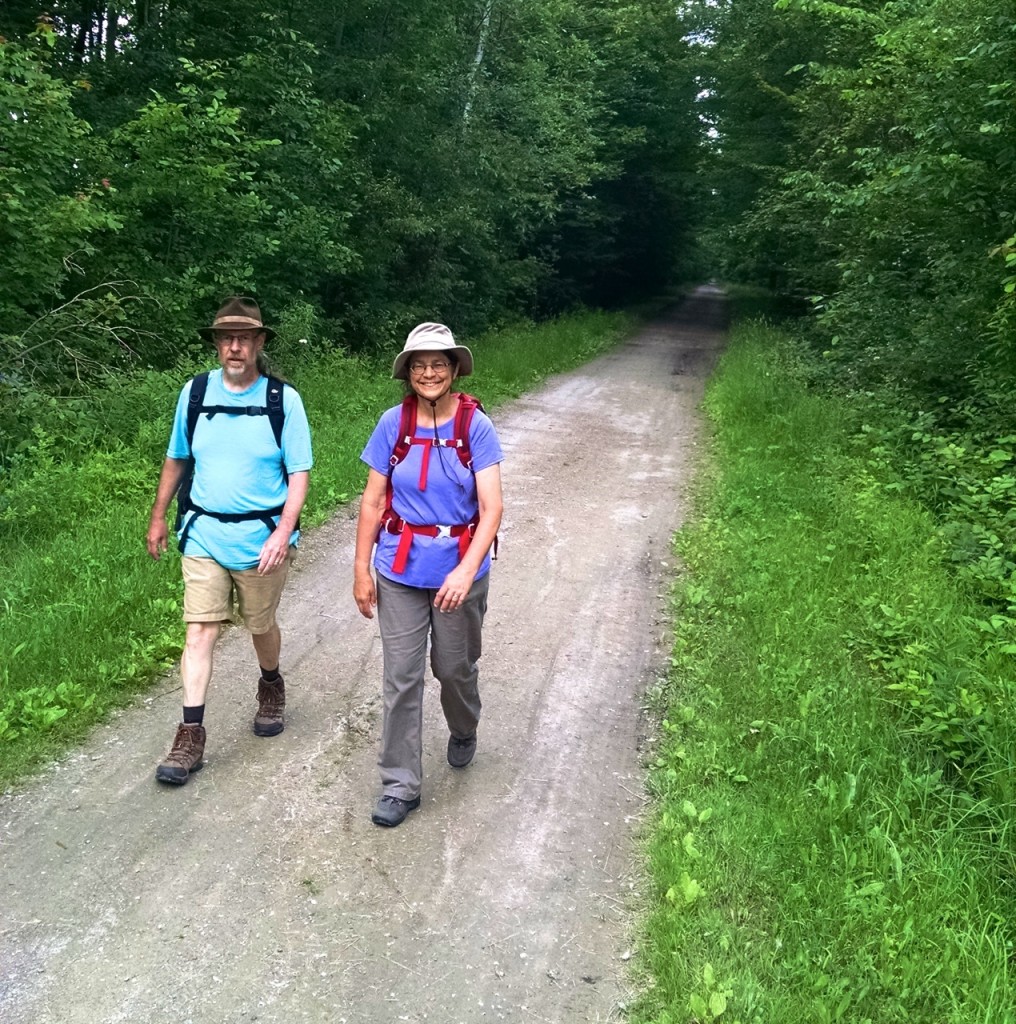 At that point it was merely a matter of trudging on. We wrapped up at 33.41 miles as measured by Endomondo, and Steven popped us into the car and drove us to the restaurant for a celebratory feast.
At that point it was merely a matter of trudging on. We wrapped up at 33.41 miles as measured by Endomondo, and Steven popped us into the car and drove us to the restaurant for a celebratory feast.
At about that point, my body seemed to have lost the ability to thermoregulate—I was shivering so hard my teeth were chattering in the slightly cool air of the South Haven evening.
Jackie wrapped her arms around me to keep me warm, and Steven got this picture as well:
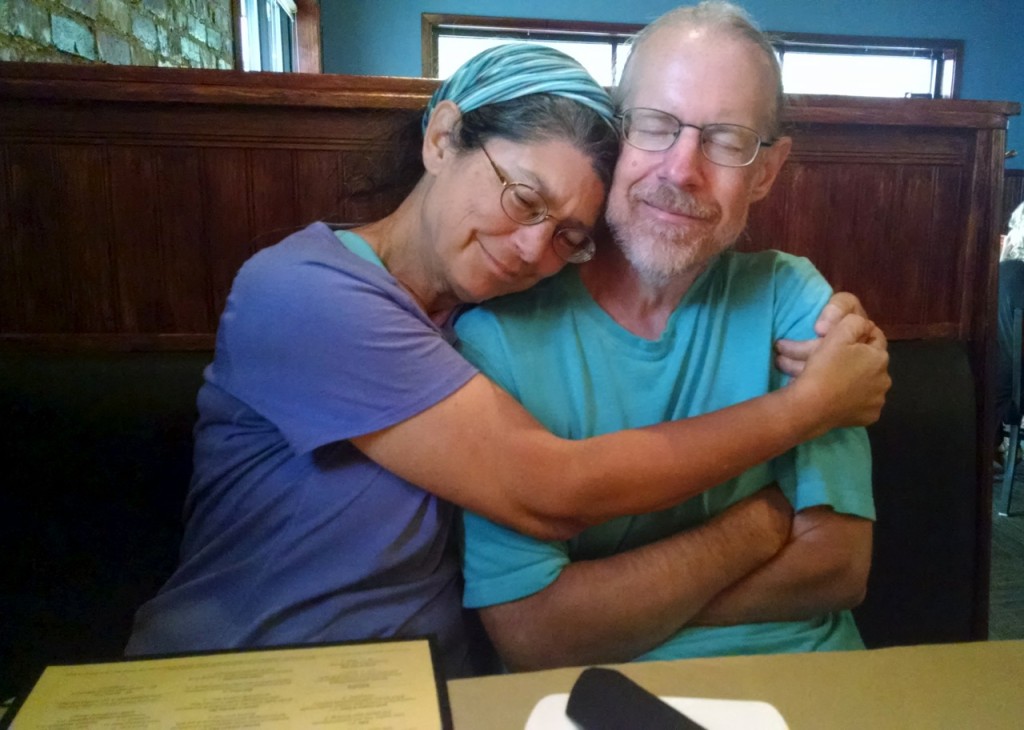 After a good night’s sleep, a big breakfast, and a nap after lunch, I think we’re all largely recovered. I stiffen up a bit if I sit still, but am not really even very sore. In the morning we got out to play Ingress, and I was able to walk around pretty much as usual. I’ll take at least one more day off before I go for a run, but basically I feel fine.
After a good night’s sleep, a big breakfast, and a nap after lunch, I think we’re all largely recovered. I stiffen up a bit if I sit still, but am not really even very sore. In the morning we got out to play Ingress, and I was able to walk around pretty much as usual. I’ll take at least one more day off before I go for a run, but basically I feel fine.
We have no plans for even longer walks, but we’ll certainly keep walking, perhaps expanding to multi-day through-hikes of the sort where your gear is schlepped for you from B&B to B&B.
It was a great experience!
Rediscovering quadrupedal movement
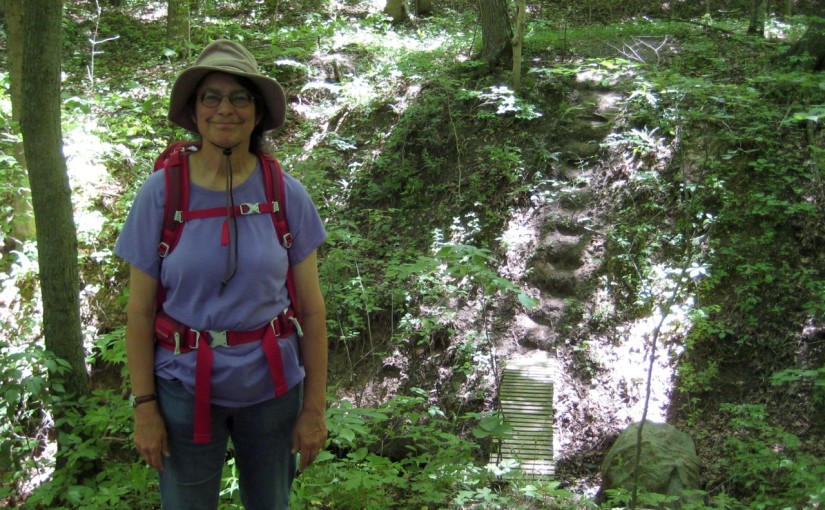
I don’t know when I quit crawling. Probably around first grade. I’m not sure why, either. Because it was something babies did, and I was grown up, I expect.
I don’t remember my parents trying to get me to quit crawling, but I’ve seen other parents try to convince their children to stay off the ground, in the interests of either propriety or cleanliness.
At any rate, most people who crawled all the time before they were five years old have so completely lost the habit it doesn’t even occur to them as a possible way to get under or through something.
When I trained with the local parkour group, the first thing the group practiced was quadrupedal movement—crawling on hands and feet.
After that practice session, I added quadrupedal movement to my own practice, and the first time I went out to do it, Jackie decided to come with me.
(It happened like this: I told Jackie I was going to go play in the woods. “What are you going to do?” she asked. “Crawl and roll on the ground,” I said. “Can I come?”)
We did some rolling, both just rolling sideways and shoulder rolls. We also did some crawling, both prone (bear crawl) and supine (crab crawl).
The actual amount of time spent crawling was pretty small—I doubt if it added up to as much as 5 minutes—but it turned out to be a surprisingly successful bit of practice, because just in the week since then, it has usefully informed the way we dealt with obstacles repeatedly.
The first time was last week at Fox Ridge State Park. At one point the trail was blocked by some fallen trees. There was more than one trunk, making the geometry a bit complex for climbing over. There was enough space underneath the bottom trunk that it would almost have been possible to just do a “step under” move, except we were wearing packs, meaning that we needed another eight or ten inches of clearance.
If I hadn’t just practiced crawling, I don’t think it would have occurred to me that the easiest way to get under the trunks was to crawl on my hands and feet. We’d probably have done something complex, like both take our packs off, have me step under the barrier, handed both packs through (or over), and then have Jackie follow under the barrier.
With the recent reminder that crawling is simple and effective, that’s what we did. I tried to step under, found that there wasn’t clearance for my pack, so crouched down further, put my hands on the ground, and crawled on through. Took about five seconds. Got my hands a little dirty. Worked great.
Yesterday we hiked the backpacking trail at Forest Glen, which presented a problem for which supine crawling made an excellent solution.
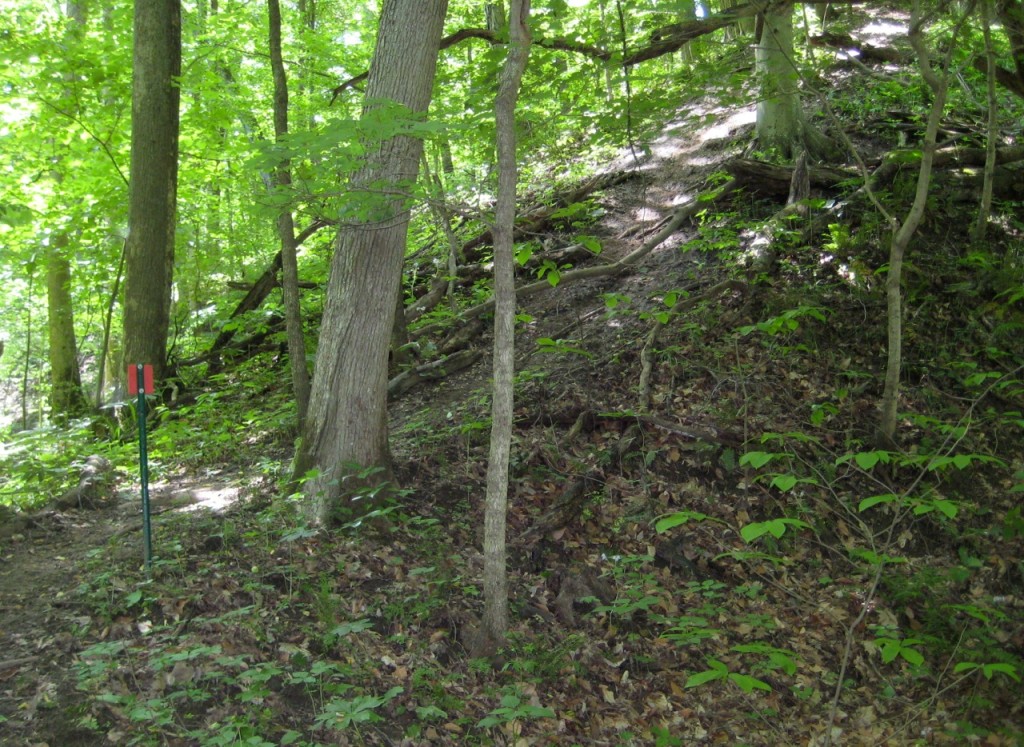 It’s hard to capture the steepness of this bit of trail in a photo. Not only was the trail steep, it was also wet, and the mud was slippery.
It’s hard to capture the steepness of this bit of trail in a photo. Not only was the trail steep, it was also wet, and the mud was slippery.
Jackie went down first, and quickly found that the combination of steep and slippery made it too dangerous to attempt to go down bipedally. She dropped down and did an inverted foot-hand crawl (aka supine crawl or crab crawl). It made for a quick, efficient, safe way down the steep bit in the path.
I followed behind, just the same way.
Rediscover quadrupedal movement. Besides being a way to get under or through something, it’s also very stable—perfect for dealing with loose, rugged, steep, uneven, or slippery ground.
Greencastle Fiber Event and Turkey Run pictures
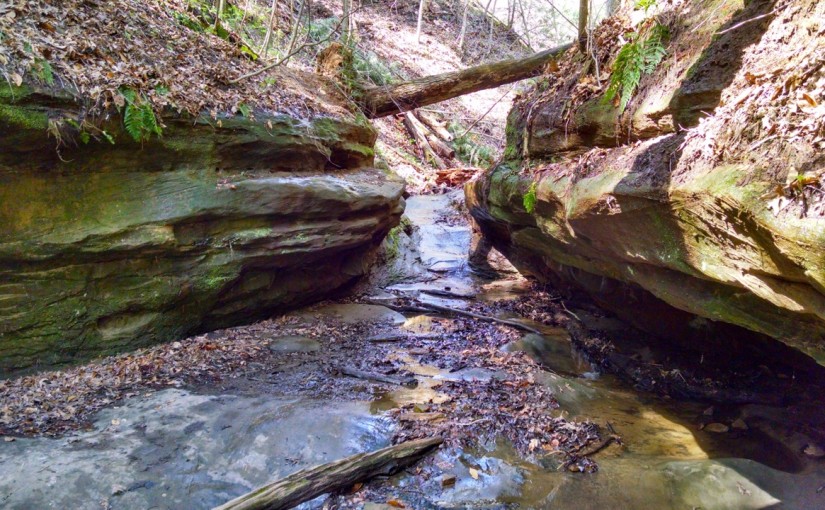
Jackie used to go to Greencastle, Indiana for the Fiber Event every year. (I think it was under different management back in those days; they called it a fleece fair.) We hadn’t gone the past couple of years, but Jackie wanted to go again this year, so we went.
Although a lot of what Jackie would buy there would sit in her stash for years, it was also a place for great finds—one year I spotted some roving made from a baby camel/merino blend that was on sale cheap because (so the vendor said) it had short fibers that made it hard to spin. But knowing that Jackie has no trouble spinning short fibers, and seeing that it was a beautiful camel-colored roving, I pointed it out and Jackie bought a bunch of it.
This year, Jackie got some yak/merino, and the vendor insisted on giving her a sample of some yak/silk blend as well.
Before coming home, having made it to that part of Indiana, Jackie and I visited Turkey Run State Park.
This time of year is a great time to visit. For one thing, there are wildflowers:
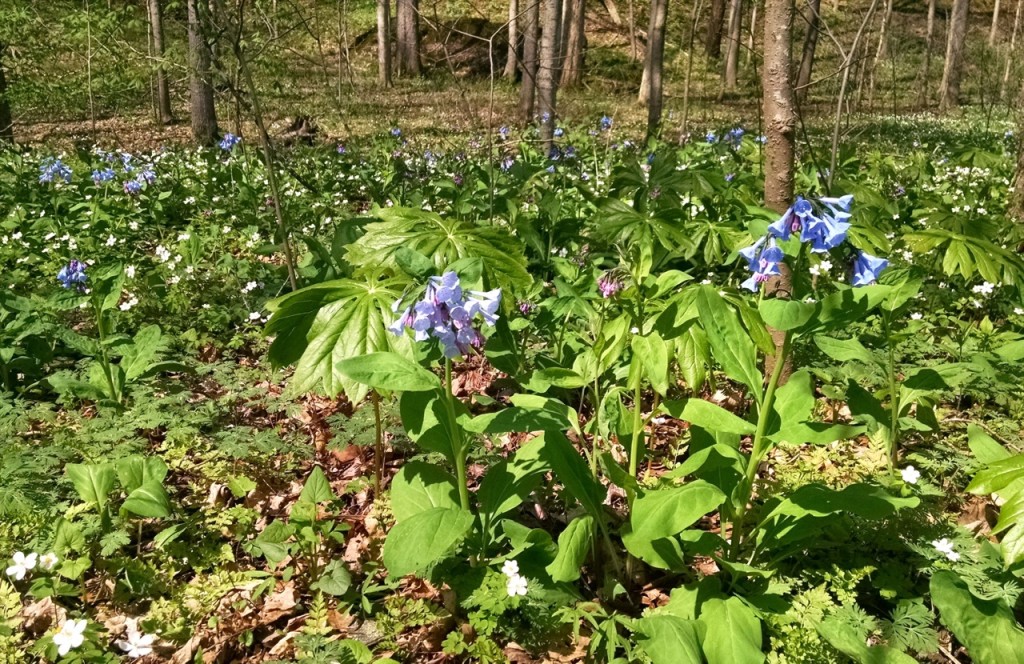
It’s a great place. My family has a long history with it—the first visit I remember was when I probably only 7 or 8 years old, and I’ve been back many times. I’ve stayed in the lodge, stayed in the cabins, and camped in the campground. And always, I’ve hiked the trails.
So, here’s a picture of me on one of the trails:
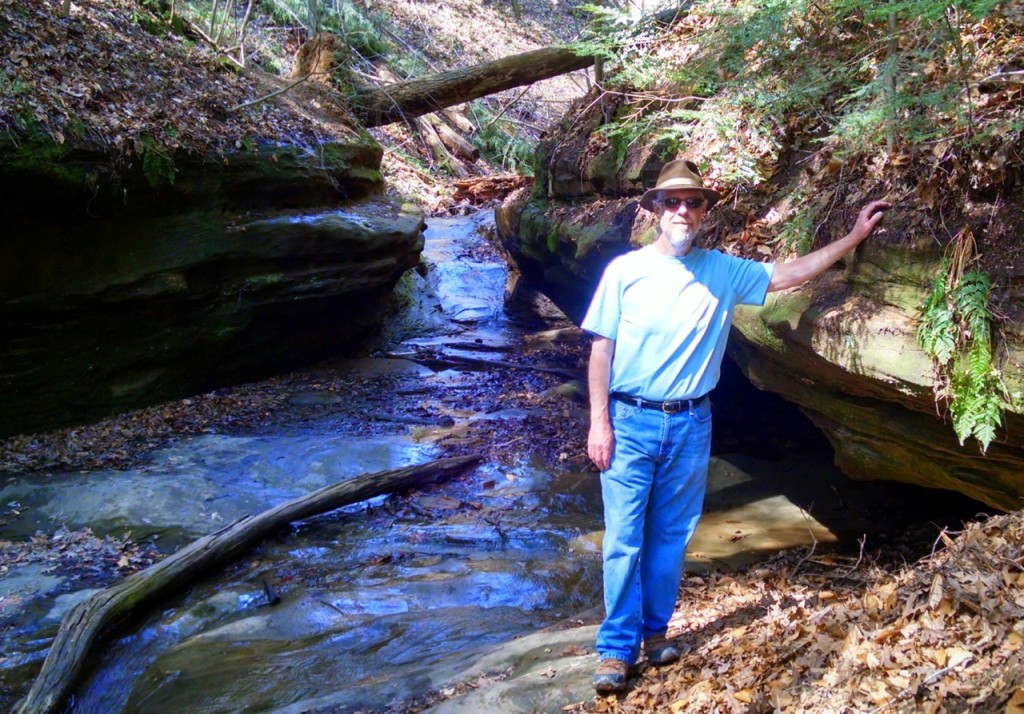
Here’s a picture of Jackie, taken not too far from there:
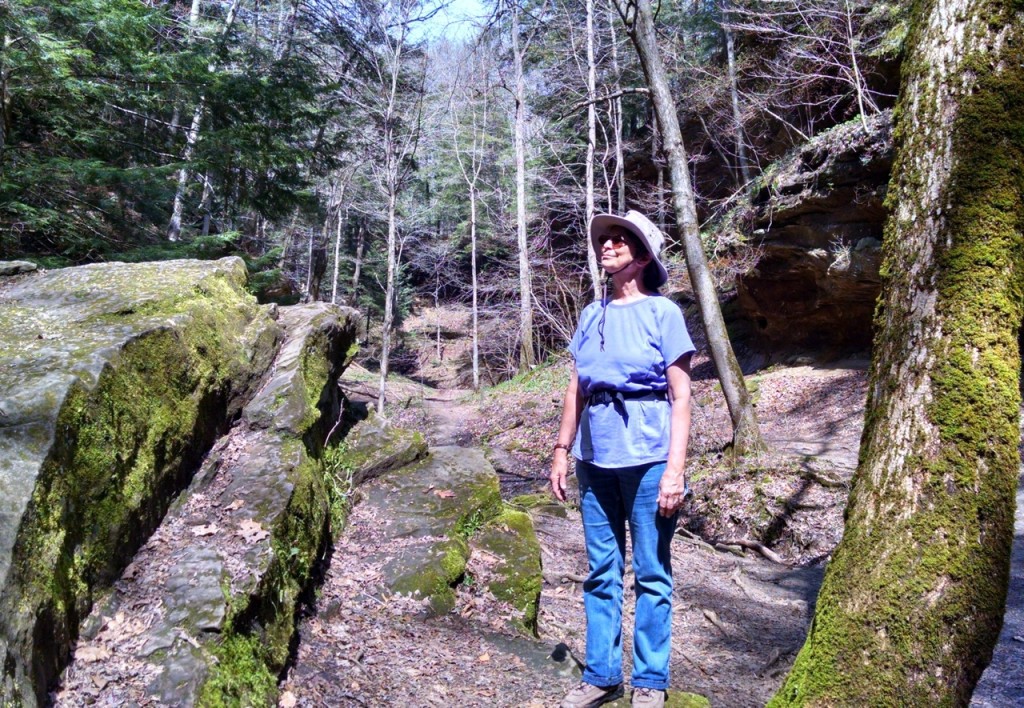
Boot failure
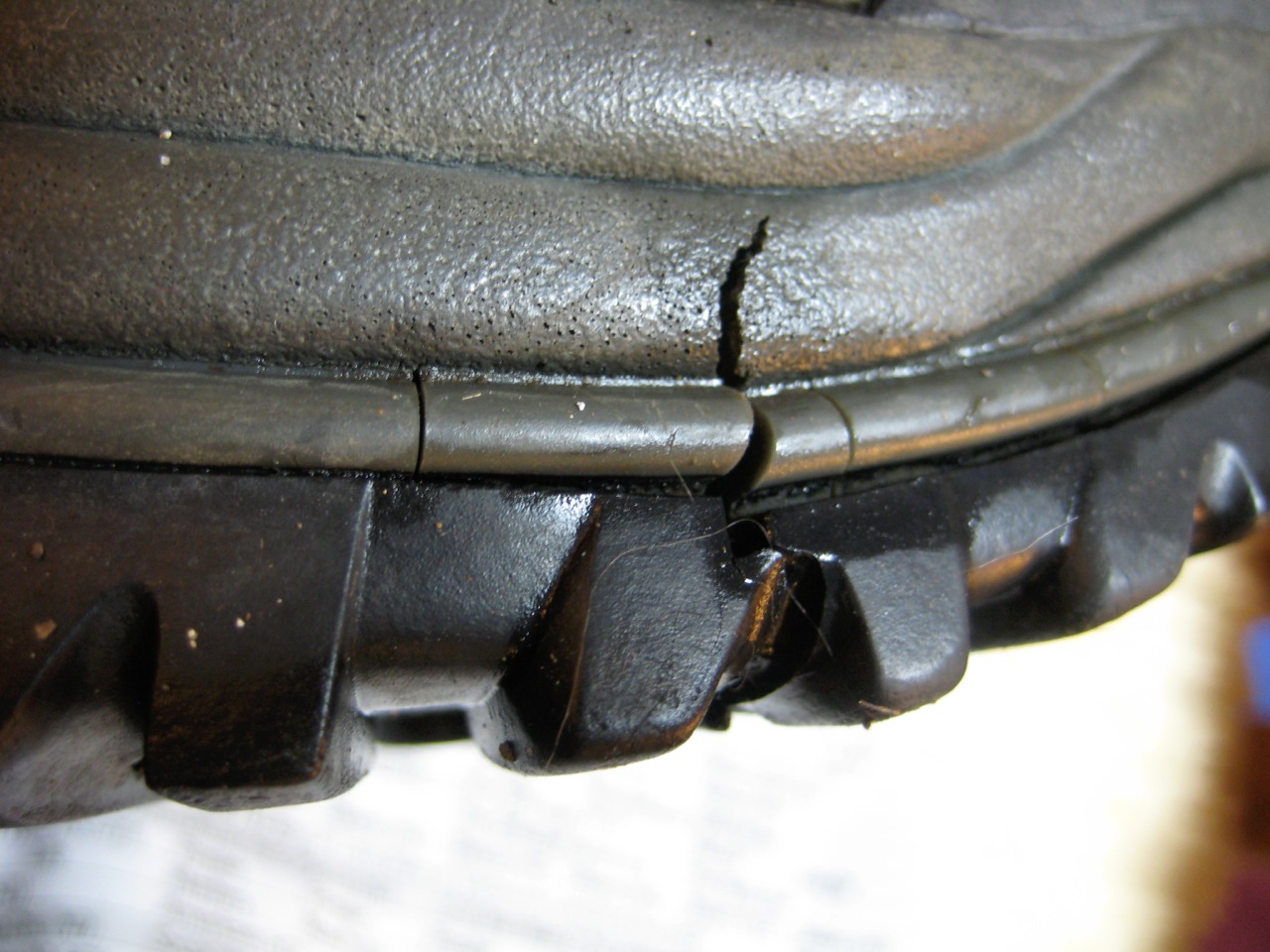
I headed out to play some Ingress this afternoon, only to be forced back before I even reached my first portal. I suffered from near-catastrophic boot failure.
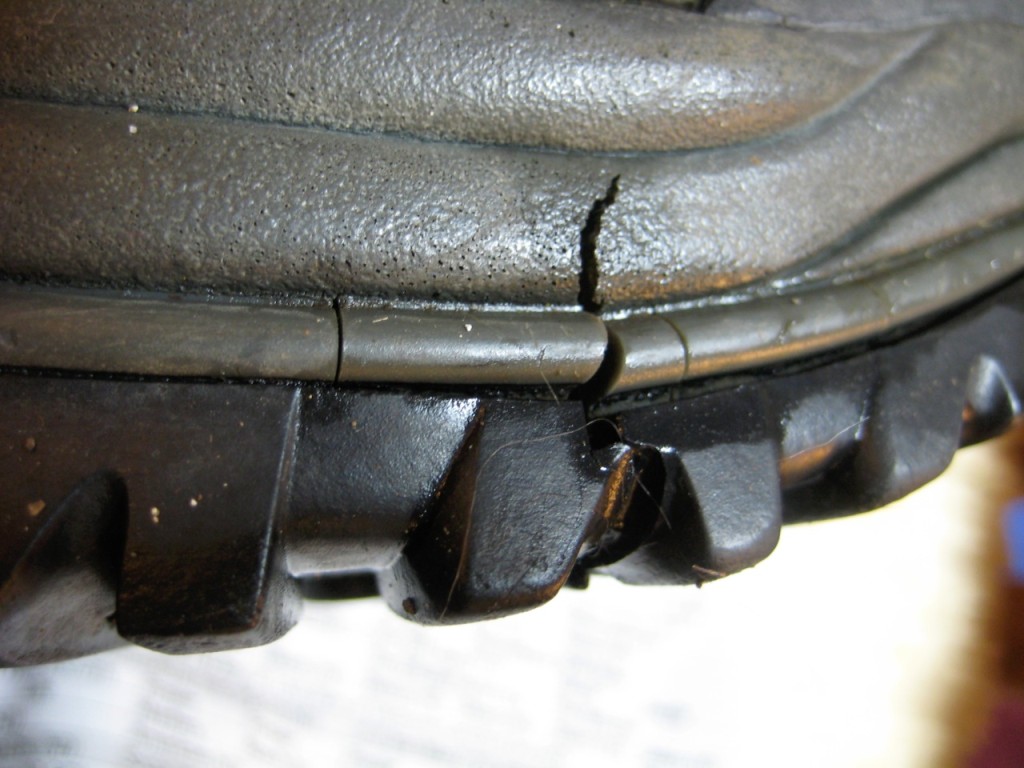 Both boots had developed a crack in the sole and mid-sole, right at the ball of the foot.
Both boots had developed a crack in the sole and mid-sole, right at the ball of the foot.
It’s possible that the crack had been there a while—it wasn’t noticeable as long as I was walking on cleared sidewalks. But as soon as I started walking through snow, it failed badly: Snow started accumulating in the crack, forcing it wider, and forcing my toes to bend backwards. Once I returned to dry pavement, a few steps knocked most of the snow out, allowing my toes to straighten out again.
The crack didn’t immediately let water in, so I actually considered continuing. But a few seconds of contemplating total boot failure at a point where returning home would require walking a mile through slushy snow, I just turned around and headed home.
Happily, these are my old, summer boots. I only got them out today because my winter hiking boots had gotten wet on each of several outings in a row, and I thought it would be best to let them dry completely, and then reapply their waterproof coating before wearing them out in the weather again.
Sometime in the next few months I’ll have to buy new summer boots. I’m okay with that—these boots were not quite as satisfactory as my previous pair of summer hiking boots. Good to get a chance to get a pair that are better. (My winter boots, on the other hand, have been very satisfactory indeed.)
Snowy day at Kaufman Lake Park, with coyote

Jackie and I decided to celebrate the snow with a walk around Kaufman Lake park—a walk that yielded more wildlife than usual. (There are larger versions of all these pictures except the one of the coyote, which is already full-size.)

This spot is just 5 minutes walk from our apartment, part of the Greenbelt Bikeway, but on the other side of the Copper Slough from Kaufman Lake.
From there, we crossed the bridge to the ring road around Kaufman Lake.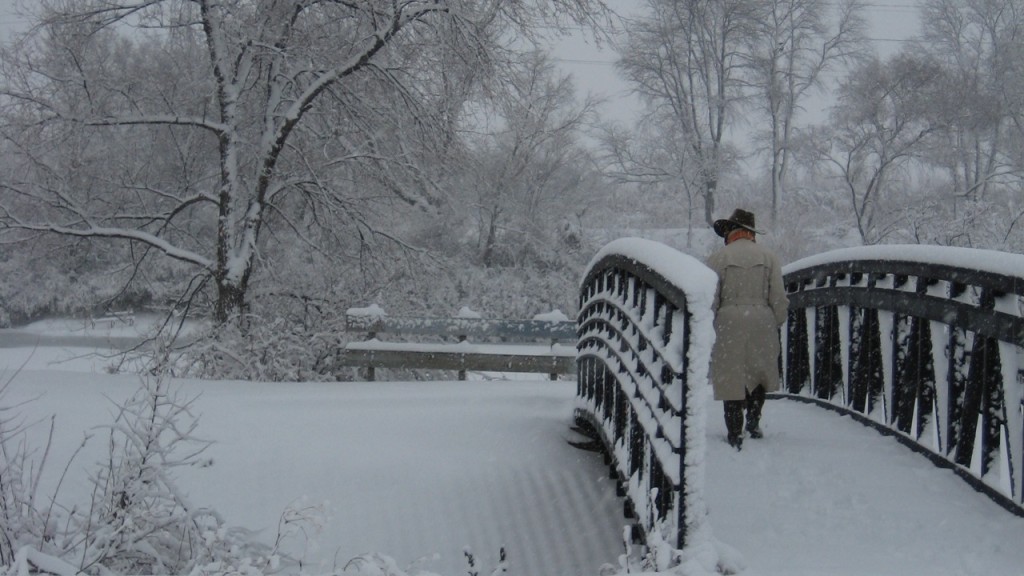
After crossing, we turned right and did a circuit of the lake. The only picture I didn’t take and regretted was one right there. The road around the lake is not really narrow—there’s room for 8 or 10 people to walk side-by-side—but in that spot, with the brush that lines the sides of the path in the summer having been cut back, exposing the steep slopes down to the lake on the left and the slough on the right, it looked really narrow.
We saw a lot of wildlife on this walk. There was a great blue heron on the lake that I spotted from a distance, and then saw take off as we approached. A kingfisher landed on a tree just across the slough, then took off and flew down the length of the slough, giving its distinctive chattering call.
Best of all, though, we saw a coyote! The first one I’ve seen since we moved from Philo. (Not that they were common around Philo either.)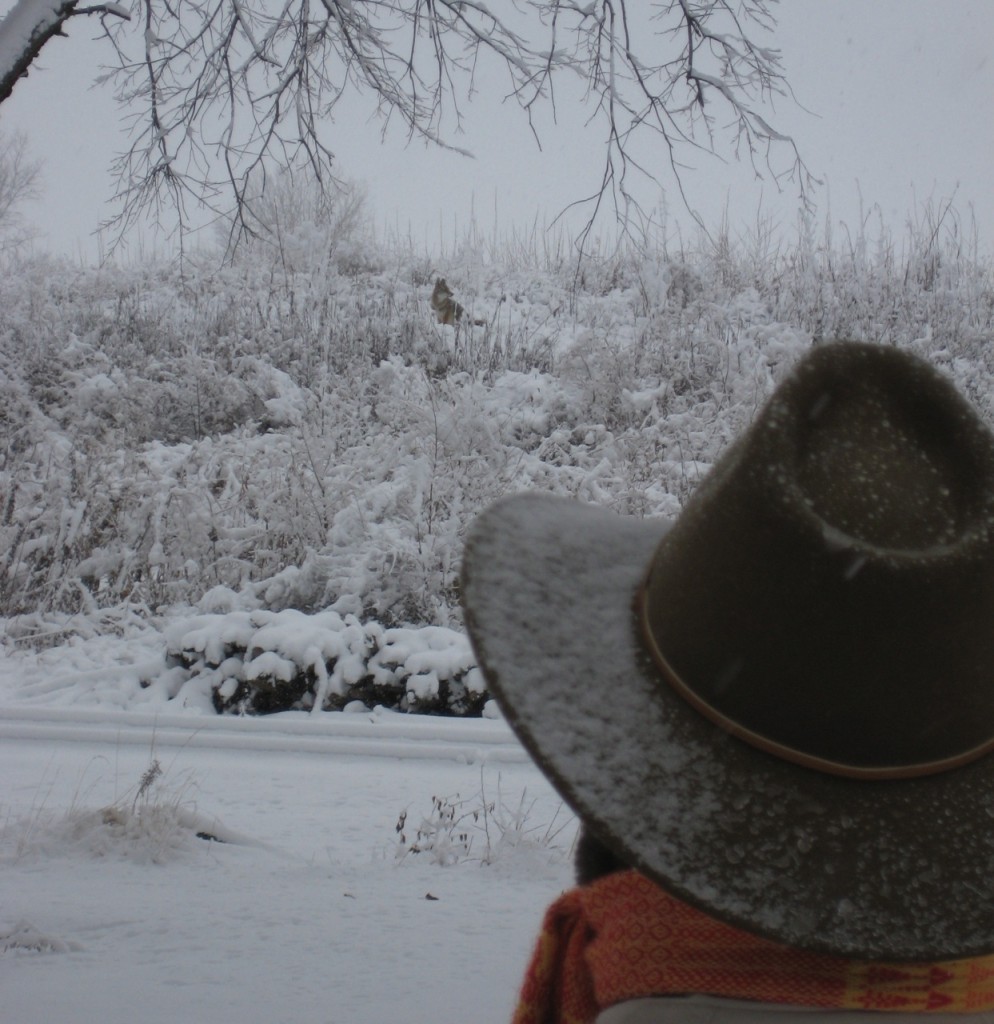
You can just see the coyote there where Jackie is looking, above and just to the left of the center of the frame. It was really too far away to photograph with my little camera, but here’s the best shot of the coyote that I got:
That was probably the peak of the walk, but we were only halfway around the lake at that point. We proceeded around.
I got a couple of pictures looking back across the lake. Here’s one with Jackie: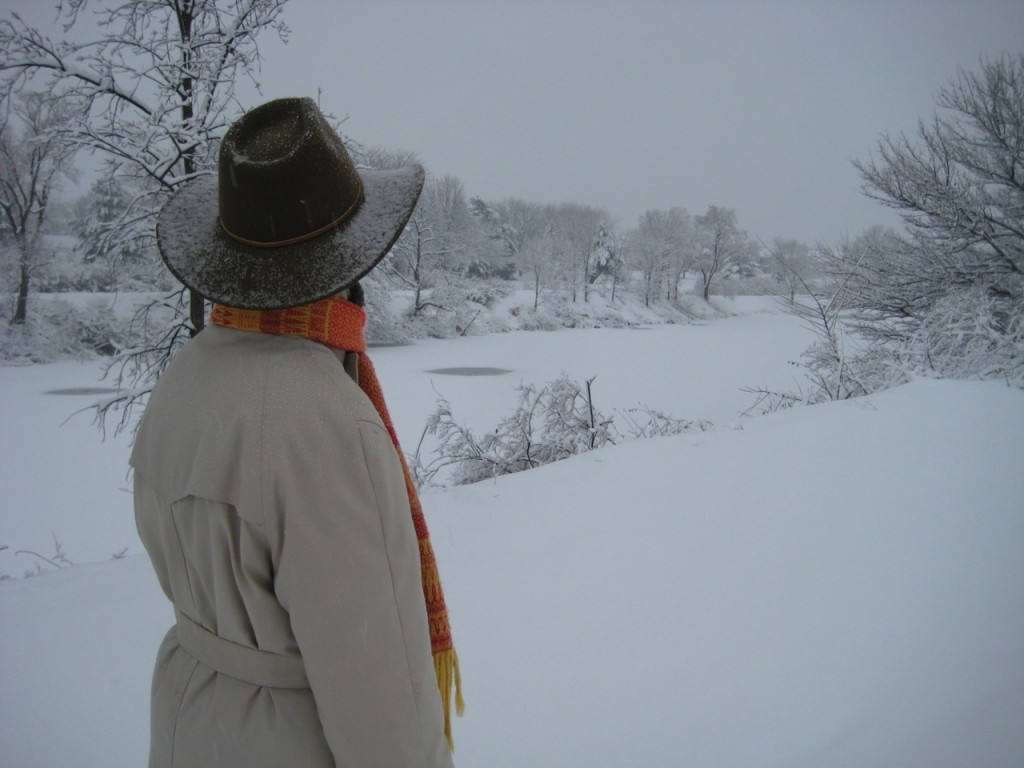
And here’s one taken later, looking back toward the bridge through some snowy branches: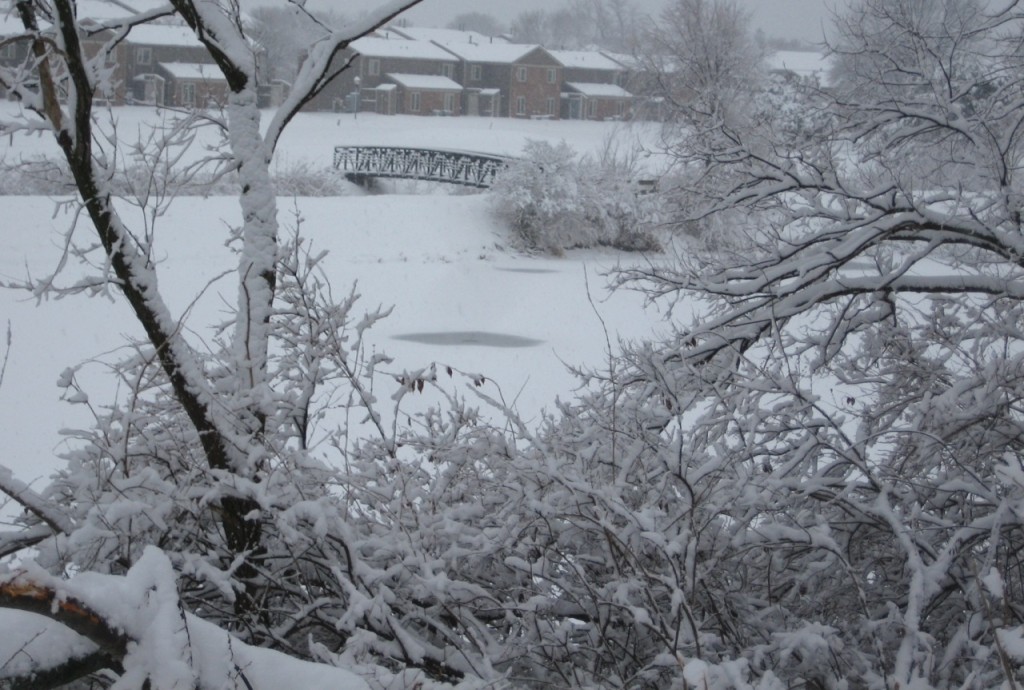
At the point where the ring road reaches the south end of the park and curves east and then back north, there’s a little picnic area. I thought it was funny to see it buried in snow: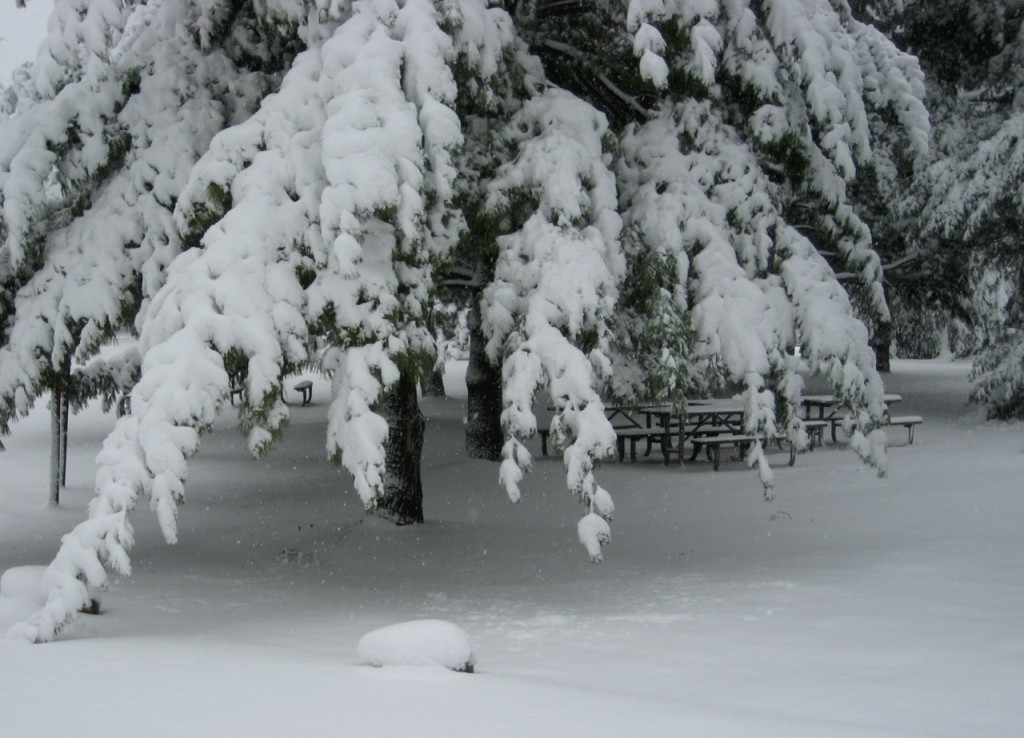
Just before we got back to the bridge and headed home, we passed the two fishing piers near the boathouse, and I got this picture of the sign which, if I remember correct, has the daily fish catch limits: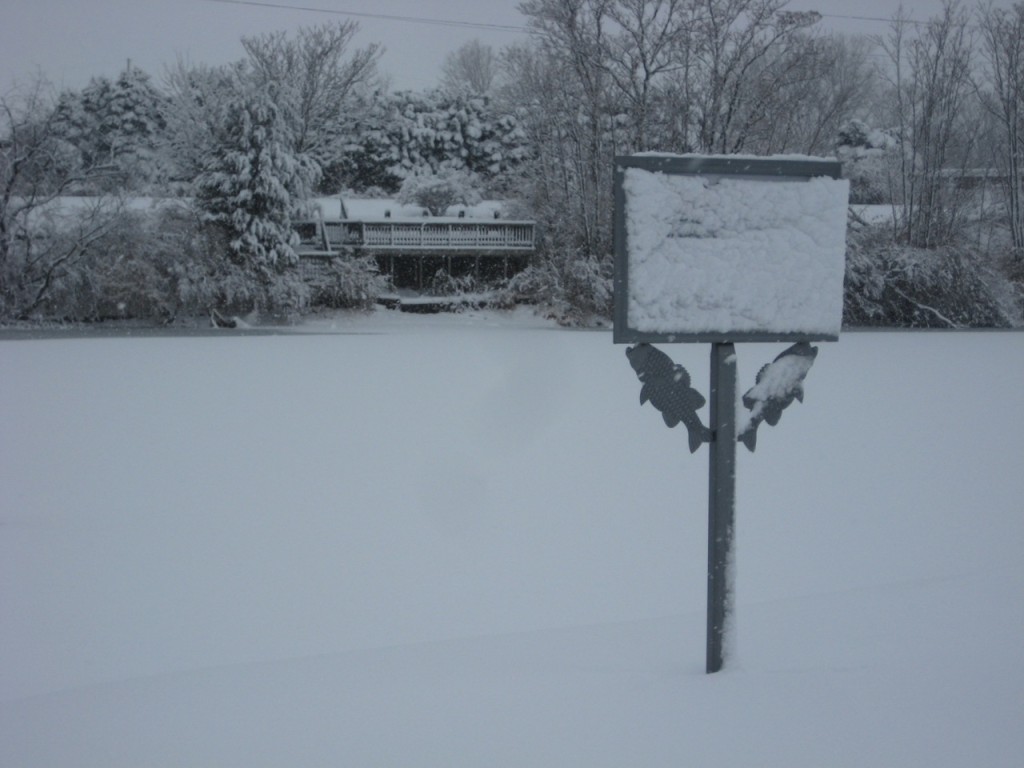
Again, I thought it was funny covered with snow.
As we approached home, I let Jackie walk in front of me, so I could throw a snowball at her. She seemed quite outraged that I’d do something so nefarious. And I can see that it would be a surprise. I’m not sure I’ve ever thrown a snowball at her before. If I did, it was probably 20 years ago. In any case, far too long.
She retaliated, as is only appropriate.
Running injury officially healed
This is just a quick post to note that my calf injury seems to have healed completely.
Last week I did two test runs—a 0.5 mile run with no turns, followed (after a rest day, to see if I had any delayed pain or swelling) by a 0.63 mile run with some turns.
When neither of those caused any problems, I went out later in the week and did my usual early-season short run of 1.5 miles.
Over the weekend, Jackie and I hiked nearly 6 miles at Fox Ridge, a state park about 60 miles from here. It’s another place where there’s elevation change available, and a set of trails to take advantage of it.
I took a rest day after the hike (having learned that lesson), and went out this morning for a 2.15 mile run, my usual mid-season short run.
All went well. No pain, no soreness, no swelling. There’s no tender spot in my calf when I poke at it.
I’ll take it quite easy as I ramp up speed and distance going forward, but I’m declaring the injury officially healed.


